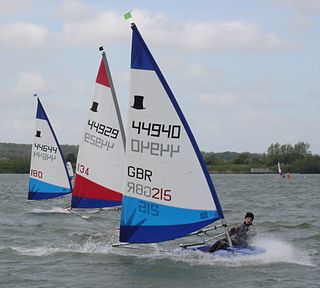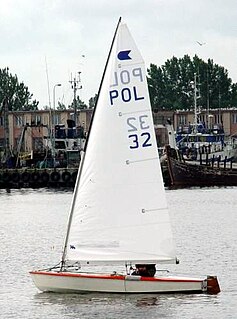Related Research Articles

Dinghy sailing is the activity of sailing small boats by using five essential controls:

Dinghy racing is a competitive sport using dinghies, which are small boats which may be rowboats, have an outboard motor, or be sailing dinghies. Dinghy racing has affected aspects of the modern sailing dinghy, including hull design, sail materials and sailplan, and techniques such as planing and trapezing.

The Topper is an 11 foot 43 kg (95 lb) sailing dinghy designed by Ian Proctor. The Topper is a one-design boat sailed mostly around the British Isles. It was recognised as a World Sailing Class. The boat is constructed from polypropylene, and is popular as a racing boat or for sail training. The class association (itca) organise racing events, which range from small travellers to major championships. The RYA run squads alongside the events; in these squads young sailors who are given specialist race coaching.

The Laser is a class of single-handed, one-design sailing dinghies using a common hull design with three interchangeable rigs of different sail areas, appropriate to a given combination of wind strength and crew weight. Bruce Kirby designed the Laser in 1970 with an emphasis on simplicity and performance.

The 49er and 49er FX is a two-handed skiff-type high-performance sailing dinghy. The two crew work on different roles with the helm making many tactical decisions, as well as steering, and the crew doing most of the sail control. Both of the crew are equipped with their own trapeze and sailing is done while cantilevered over the water to the fullest extent to balance against the sails.

The Laser Standard or ILCA 7 is a popular one-design class of single-handed sailing dinghy, originally built by Performance Sailcraft Canada. The laser is cat rigged, with a single mainsail and is a simple, light and fast boat to sail. The Laser Standard is the original of the Laser family of dinghys, which also includes the Laser Radial and Laser 4.7, both of which use the same hull, but have smaller rigs.

The OK Dinghy is an international class sailing dinghy, designed by Knud Olsen in 1956.

The Byte is a small one-design sailing dinghy sailed by one person. It was designed by Canadian Ian Bruce, who also commissioned and marketed the Laser.

The Wanderer is a 14-foot Fibreglass hull Bermuda rigged sailing dinghy designed by Ian Proctor. One of the main objectives of the design was to produce a robust safe and versatile dinghy that could be used for knockabout day sailing and cruising as well as racing, but was light enough to be handled ashore.

The RS300 is a modern racing sailing dinghy made by RS Sailing. The RS300 is a one-design, single-handed, hiking dinghy with a PY of 972. Designed by Clive Everest and first produced in 1998, it is inspired by the International Moth, of which Everest was a successful designer.

The RS800 is a light-weight sailing dinghy designed by Phil Morrison and manufactured by RS Sailing. The boat is sailed by two people both on trapeze and has a main, jib and spinnaker. The RS800 has a Portsmouth Yardstick number of 799 and a D-PN of 77.0. There is a large racing circuit in the UK, and some European events each year.
The Scorpion is a British National class of a small sailing dinghy. The Scorpion is a lightweight, high performance, two person, hiking racing dinghy. Its adjustable rig enables sailing in all weathers for crews of all weights, ages and experiences. The Scorpion was originally designed for launch and recovery through Cornish surf at Porthpean in St Austell Bay. Its 14ft hard chine planing hull is built to strict measurements while rig controls and cockpit layout are left to personal choice.

The Bermuda Fitted Dinghy is a type of racing-dedicated sail boat used for competitions between the yacht clubs of Bermuda. Although the class has only existed for about 130 years, the boats are a continuance of a tradition of boat and ship design in Bermuda that stretches back to the earliest decades of the 17th century.
The 2000(formerly the Laser 2000) is a performance sailing dinghy designed by Phil Morrison and currently sold by RS Sailing. It combines a traditional GRP hull and foam sandwich deck moulding with a modern asymmetric rig including a furling jib, reefing mainsail and single line gennaker hoist system.

The RS400 is a light-weight sailing dinghy designed by Phil Morrison and manufactured by RS Sailing. The dinghy is sailed by two people and has a main, a jib and an asymmetric spinnaker. It has a PY of 948 and a D-PN of 82.3.

The RS Tera is a one-man monohull dinghy in the RS Sailing range of sailing boats. It is recognised by the International Sailing Federation (ISAF) as an international class, and is a popular boat for beginners and for children to race.RS also makes lots of different boats.

RS Sailing is an international designer, builder and supplier of sailboats and dinghies and associated goods and services supported by a worldwide dealer network and class associations.
The RS Vision is a sailing dinghy created by RS Sailing designed for 2 crew members. It can, however, be sailed by a larger crew or be single handed. It is sailed at many clubs around the world.

The RS100, first launched in 2009 by RS Sailing, is a singlehanded skiff. Possessing an asymmetric spinnaker the boat has two PY numbers of 981 for the 10.2 rig and 1004 for the 8.4 rig. The RS100 has a racing event circuit in the United Kingdom and in Europe, with the Eurotour beginning in 2011.

The RS Aero is a British sailing dinghy that was designed by Jo Richards as a one-design racer and first built in 2014.